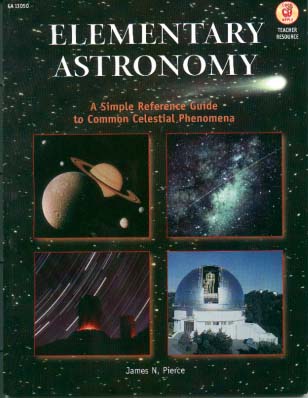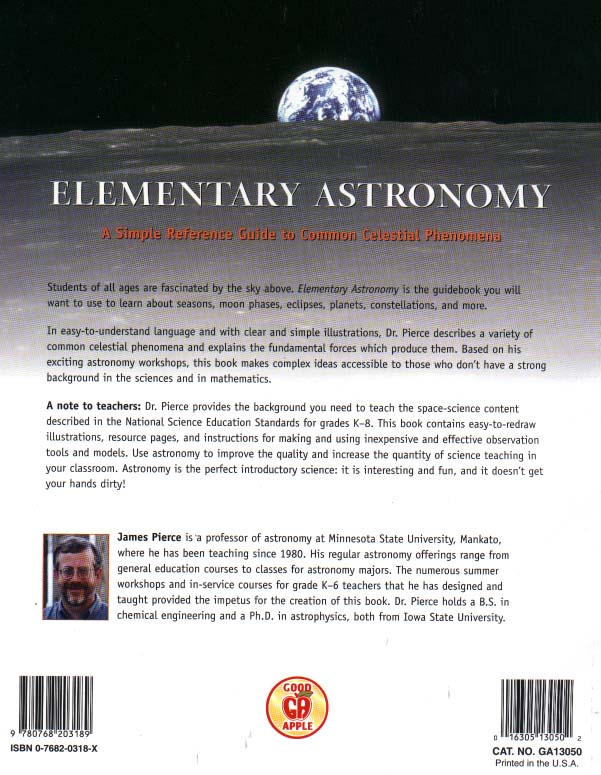Elementary Astronomy
a text by
Dr. James N. Pierce
Emeritus Professor of Astronomy at
Minnesota State University, Mankato
- Title: Elementary Astronomy: A Simple Reference Guide to Common Celestial Phenomena
- Author: James N. Pierce
- Copyright: 2000 by Good Apple
- Publisher: Frank Schaffer Publications
(originally published by Good Apple,
a Division of Frank Schaffer Publications, Inc.,
which was bought in 2001 by McGraw-Hill Children’s Publishing,
which was then acquired in 2004 by School Specialty,
and for a time was offered through their School Specialty Children’s Publishing brand,
(but still under the Frank Schaffer label)
before becoming the property of Carson-Dellosa Publishing in 2009,
who did nothing with the book, but kindly returned the rights to me in 2012. - Needless to say, this book is not currently available from any publisher;
but used copies can sometimes be obtained (try Amazon).
See also the note at the bottom of this page.

- Good Apple/FSP Catalog Number: GA13050
- ISBN: 0-7682-0318-X
- Format: 8 3/8″ x 10 7/8″, paperback, 112 pages
- Price: originally about $15
Note: The original publisher subtitled the first printing of Elementary Astronomy as “A Simple Reference Guide to Our Solar System“. In the second printing, this was modified to “A Simple Reference Guide to Common Celestial Phenomena“, which more accurately reflects the contents. Aside from a few corrections, the two versions are identical. Images depicted here are from the second printing.
Elementary Astronomy is a book written specifically for teachers (and parents) of students in grades K-6. The astronomy topics it covers are those most commonly found in these grade levels: Earth and Sun; night and day; seasons; phases of the Moon; eclipses; the solar system; planets; the night sky; constellations. Also included are explanations of other terms and phenomena necessary to understand these topics, such as gravity, orbits, rotation, revolution, shadows, equinoxes, solstices, and star trails.
No prior knowledge of astronomy is required; the book is intended as a self-contained tutorial for those wishing to learn the basics of everyday astronomy. Although it contains enough numbers to serve as a convenient reference for data on planets and other bodies, Elementary Astronomy is not heavy on mathematics. Most of the material is presented using explanatory text and simple sketches.
Elementary Astronomy will be especially useful to
- teachers in elementary and middle schools who wish to learn enough astronomy to cover the astronomy units in their science programs;
- teachers at any level who need a simple, handy reference that
- explains easily observable astronomical phenomena and
- provides basic astronomical data for use in mathematical applications;
- astronomy educators who need an appropriate text to accompany
- astronomy courses for elementary education majors and
- astronomy workshops for teachers;
- parents of students who ask questions about things they see in the sky.
Contents:

- Introduction
- Chapter 1: The Earth, the Moon, and the Sun
- Chapter 2: Gravity and Orbits
- Chapter 3: Earth’s Motions and Seasons
- Chapter 4: Moon Motions and Phases
- Chapter 5: Eclipses
- Chapter 6: The Solar System
- Chapter 7: Planet Properties
- Chapter 8: Motions of the Night Sky
- Chapter 9: Constellations and Star Charts
- Chapter 10: Conclusion
- Appendix
- Glossary
- Index
I have revised Elementary Astronomy, correcting changes made by the first editors and updating content as needed.
The new Elementary Astronomy is now available for FREE download.
